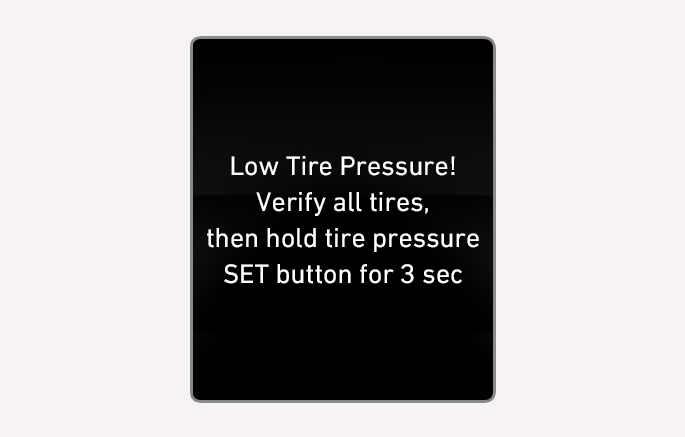Low tire pressure light

2C_TireLowPressureWarning
When the Low Tire Pressure warning light (
If the warning light illuminates, reduce your speed, and also avoid hard cornering and sudden braking. We recommend that your vehicle be inspected by an authorized HYUNDAI dealer.
Check the condition and inflation pressure of all four tires, then reset the TPMS (For more information, refer to the "Resetting TPMS" section in this chapter) or take required counteractions such as repairing or replacing the tires.
When an authorized HYUNDAI dealer is not nearby, stop at a safe place and check the condition and inflation pressure of all four tires, then reset the TPMS.
If you cannot unable to adjust the inflation pressure, use the Tire Mobility Kit (TMK) to repair or replace the under-inflated tire with a spare tire (if equipped). We recommend that your vehicle be inspected by an authorized HYUNDAI dealer.
You may not be able to identify a tire with low pressure by simply looking at it. Always use a good quality tire pressure gauge to measure. Note that a tire that is hot (from being driven) has a higher pressure measurement than a tire that is cold.
-
The warning light may remain on even after replaced with a spare tire. Replace your vehicle with original sized tires. After rotating the position of a tire or wheel.
-
Note that the TPMS is not a substitute for proper tire maintenance. It is the driver’s responsibility to maintain the appropriate recommended inflation pressure, and the tires must be inspected periodically to maintain the recommended inflation pressure.
When the Low Tire Pressure warning light is on.
-
The Low Tire Pressure warning light may illuminate when the TPMS is not reset when necessary.
-
In winter or cold weather, the Low Tire Pressure warning light may illuminate if the tire pressure was adjusted to the recommended tire inflation pressure in warm weather. It does not mean your TPMS is malfunctioning because the decreased temperature leads to a proportional lowering of tire pressure. Check the tire inflation pressure and adjust the tires to the recommended tire inflation pressure.
-
TPMS performance may reduce in the following situations when:
-
Reset is done incorrectly.
-
Original sized tires are not installed.
-
Driving on rough roads such as snowy, slippery roads, or unpaved roads.
-
Repeating hard cornering, sudden acceleration, or sudden braking.
-
Driving too slow or too fast.
-
The vehicle is overloaded.
-
Snow chains are installed.
-
-
Continued driving on low pressure tires can cause the tires to overheat and fail. Under-inflation may cause the vehicle to be unstable and reduce tire life and energy economy, increase braking distance, and other tire failures that result in loss of vehicle control. We recommend that your vehicle be inspected by an authorized HYUNDAI dealer and maintain the recommended inflation pressure.
-
The TPMS cannot alert you to severe and sudden tire damage caused by external factors. If you notice any vehicle instability, immediately take your foot off the accelerator pedal, apply the brakes gradually with light force, and slowly move to a safe position off the road.